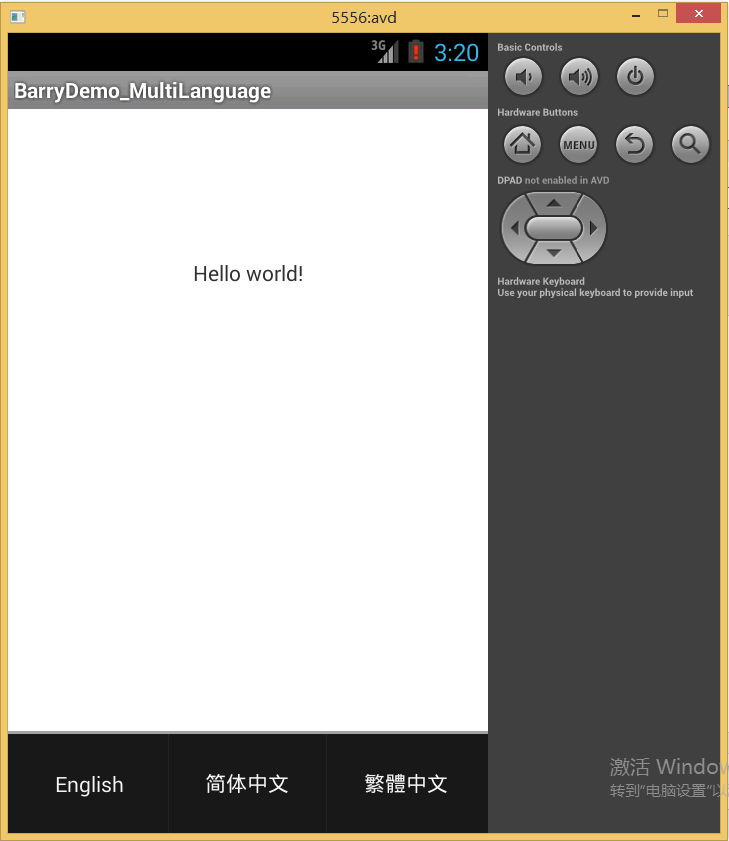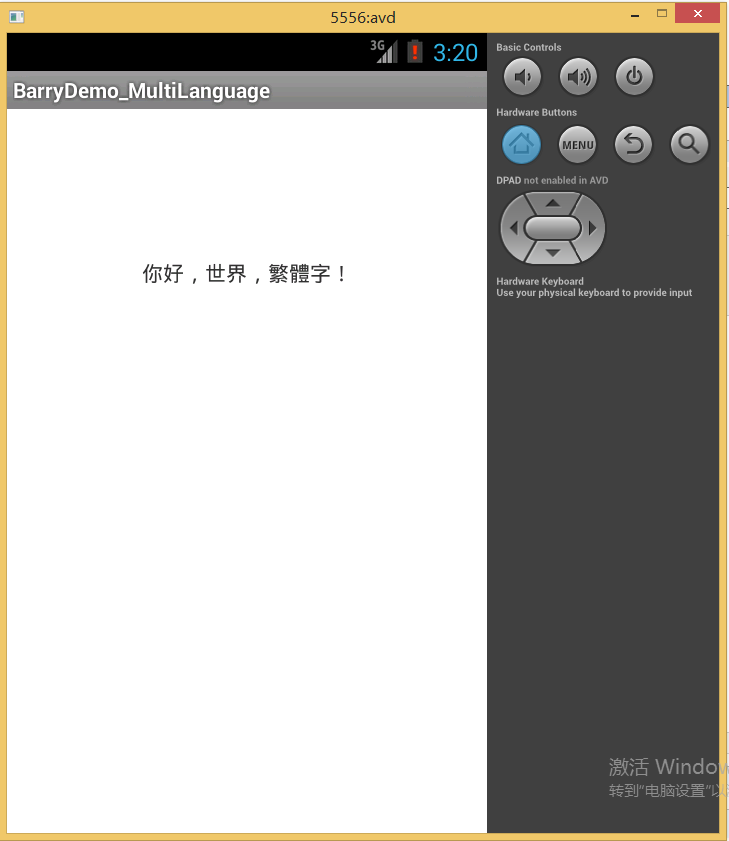参考源码:http://download.csdn.net/detail/barryhappy/7176709
将使用support.v7的项目修改了一下,变成了一个不使用actionbaractivity而是activity的。减少报错。
http://download.csdn.net/detail/mcdullsin/8290923
一、在说多语言的时候首先说说如何减少“hard code”
什么是“hard code”,例如:java文件中直接使用了汉字字符串等。正确做法是将它放在资源文件中,并在需要的地方进行引用。
说一说如何在java文件等地方使用string.xml中的资源:
获取string.xml文件里面的值有几个不同的地方。
1.在AndroidManifest.xml与layout等xml文件里:
android:text="@string/resource_name"
2.在activity里:
方法一:this.getString(R.string.resource_name);
方法二:getResources().getString(R.string.resource_name);
3.在其他java文件(必须有Context或pplication)
方法一: context.getString(R.string.resource_name);
方法二: application.getString(R.string.resource_name);
二、接下来分析多语言的源码及如何使用
首先效果截图:


这位大哥的博客中很好地说明了android多语言国际化:
http://www.cnblogs.com/bluestorm/archive/2013/04/01/2993554.html

android的多语言原理是这样:
它会检查android手机的默认配置,然后到具体的values下面去读取字符串。
那位大哥博文中的话:
“
在Android工程的res目录下,通过定义特殊的文件夹名称就可以实现多语言支持。比如我们的程序兼容简体中文、英文,在values文件夹中建立默认strings.xml,再建立values-zh-rCN文件夹。
在每个文件夹里放置一个strings.xml,strings.xml里是各种语言字符串。如果涉及到参数配置类xml文件夹名称也要改成xml-zh、xml。这样在android的系统中进行语言切换,所开发的程序也会跟着切换语言。
”
特殊的文件夹名!
说明文件夹名每个是固定的。
那么分析这篇博文中的项目做了什么事情。
它做的事点击menu会弹出语言设置,然后再进行语言的切换。
Java源码如下:
package barry.demo.multilanguage; import java.util.Locale; import android.support.v4.app.Fragment; import android.app.Activity; import android.content.res.Configuration; import android.os.Bundle; import android.view.LayoutInflater; import android.view.Menu; import android.view.MenuItem; import android.view.View; import android.view.ViewGroup; import android.widget.TextView; import android.os.Build; public class MainActivity extends Activity { @Override protected void onCreate(Bundle savedInstanceState) { super.onCreate(savedInstanceState); setContentView(R.layout.activity_main); } @Override public boolean onCreateOptionsMenu(Menu menu) { getMenuInflater().inflate(R.menu.main, menu); return true; } @Override public boolean onOptionsItemSelected(MenuItem item) { Configuration config = getResources().getConfiguration(); switch (item.getItemId()) { case R.id.action_english: config.locale = Locale.ENGLISH; break; case R.id.action_simple_chinses: config.locale = Locale.SIMPLIFIED_CHINESE; break; case R.id.action_traditional_chinese: config.locale = Locale.TRADITIONAL_CHINESE; break; default: return true; } getResources().updateConfiguration(config, getResources().getDisplayMetrics()); ((TextView)findViewById(R.id.textViewHello)).setText(R.string.hello_world);; return true; } }
主布局文件如下:
<FrameLayout xmlns:android="http://schemas.android.com/apk/res/android" xmlns:tools="http://schemas.android.com/tools" android:id="@+id/container" android:layout_width="match_parent" android:layout_height="match_parent" tools:context="barry.demo.multilanguage.MainActivity" tools:ignore="MergeRootFrame" > <TextView android:id="@+id/textViewHello" android:layout_width="match_parent" android:layout_height="218dp" android:gravity="center" android:text="@string/hello_world" /> </FrameLayout>
菜单布局文件如下:
<menu xmlns:android="http://schemas.android.com/apk/res/android" xmlns:app="http://schemas.android.com/apk/res-auto" xmlns:tools="http://schemas.android.com/tools" tools:context="barry.demo.multilanguage.MainActivity" > <item android:id="@+id/action_english" android:orderInCategory="100" android:title="@string/english"/> <item android:id="@+id/action_simple_chinses" android:orderInCategory="100" android:title="@string/simple_chinese"/> <item android:id="@+id/action_traditional_chinese" android:orderInCategory="100" android:title="@string/traditional_chinese"/> </menu>
在这里关键有一个问题就是:
当点击按钮之后,会对文件进行刷新,是每个字符串textview、listview都要刷新。
getResources().updateConfiguration(config, getResources().getDisplayMetrics());
((TextView)findViewById(R.id.textViewHello)).setText(R.string.hello_world);;
如果涉及到服务器就不好刷新了。
而且即使本地文件刷新量也有点大了。
所以做法是不能在每个页面都有语言切换按钮,而应该将语言切换按钮放在登陆页。